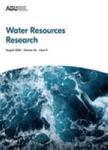版权所有:内蒙古大学图书馆 技术提供:维普资讯• 智图
内蒙古自治区呼和浩特市赛罕区大学西街235号 邮编: 010021

作者机构:Indian Inst Technol IITB Monash Res Acad Mumbai Maharashtra India Monash Univ Dept Civil Engn Clayton Vic Australia Univ Melbourne Dept Infrastruct Engn Parkville Vic Australia Indian Inst Technol Dept Civil Engn Mumbai Maharashtra India Indian Inst Technol Interdisciplinary Program Climate Studies Mumbai Maharashtra India Bur Meteorol Melbourne Vic Australia
出 版 物:《WATER RESOURCES RESEARCH》 (水资源研究)
年 卷 期:2022年第58卷第7期
页 面:e2021WR031508-e2021WR031508页
核心收录:
学科分类:0710[理学-生物学] 0830[工学-环境科学与工程(可授工学、理学、农学学位)] 08[工学] 081501[工学-水文学及水资源] 0815[工学-水利工程]
基 金:IITB-Monash Research Academy
主 题:IDF of low flows non-stationarity droughts climate teleconnections extreme value theory Generalized Linear Models
摘 要:The intensity, duration, and frequency (IDF) of low streamflow events are often considered stationary in time. Given droughts are likely to become more frequent and extreme, here those IDFs are analyzed for their non-stationarity in relation to three climate drivers, namely, the El Nino-Southern Oscillation, the Indian Ocean Dipole, and the Southern Annular Mode. For this, low flow events were identified for 161 unregulated catchments in Victoria, Australia. The relationship between the climate drivers and the IDFs were developed using covariate-based non-stationary statistical models. We found that several of these catchments exhibit strong non-stationary influences from the climate modes. Such catchments have a higher probability of experiencing more intense, prolonged, and/or frequent low flows when a dry phase of these climate drivers occurs. We found that catchments having strong evidence of non-stationary frequency (n = 77) were more compared to those having non-stationary intensity (n = 19) or duration (n = 34). Further, we derived projected indices of these climate drivers from CMIP5 models for the RCP8.5 scenario. These indicate an intensification in the dry phase of the climate drivers. Using information of the projected indices in the IDF models, we found that future dry phases of these climate drivers are likely to further increase the probability of experiencing higher magnitudes of low flow IDFs in catchments non-stationary in these characteristics in relation to one or more of these climate drivers. Frequency shows greater response to future dry phases of these drivers than intensity or duration of low flows.